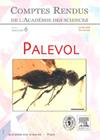IF 1.3
4区 地球科学
Q3 PALEONTOLOGY
引用次数: 0
摘要
尽管对双齿兽的多样性和分布进行了近两个世纪的深入研究,但最近二十年的进展使21世纪初成为双齿兽的复兴。在此,我们介绍了Woznikella triradiata n. gen., n. sp.,这是一种晚三叠世的欧洲kannemeyeriform,具有stahleckeriids的亲缘关系,可能代表了该家族的早期分化谱系,在此之前,该家族分裂为1988年的Placeriinae King和1961年的Stahleckeriinae Lehman。Woznikella triradiata n. gen., n. sp.与其他双齿动物的区别在于其自形,细长的肩胛骨具有明显扩展的背侧和腹侧部分,肩峰指向前,肩胛骨不明显。此外,我们回顾了三叠纪Dicynodontia的全球发现,包括零碎的、不确定的发现,可能捕获了隐多样性,并分析了二叠纪和三叠纪Dicynodontia的生物地理学。根据我们的研究结果,整个二叠纪和三叠纪的非洲东南部地区(马拉维、莫桑比克、纳米比亚、南非、坦桑尼亚、赞比亚)是双齿兽多样性的热点地区,也是向北和向西迁移的谱系的起源点。多个分类群独立迁移到美洲和欧亚大陆,表明南半球和北半球地区之间有开放通道。然而,从北半球向南迁徙似乎非常罕见。本文章由计算机程序翻译,如有差异,请以英文原文为准。
Woznikella triradiata n. gen., n. sp. – a new kannemeyeriiform dicynodont from the Late Triassic of northern Pangea and the global distribution of Triassic dicynodonts
Despite nearly two centuries of intensive research of dicynodont diversity and distribution, the progress of the last two decades makes the early 21st century a dicynodont renaissance. Here we introduce Woznikella triradiata n. gen., n. sp., a Late Triassic European kannemeyeriiform with stahleckeriid affinities that may represent an early diverging lineage of that family, preceding its split into Placeriinae King, 1988 and Stahleckeriinae Lehman, 1961. Woznikella triradiata n. gen., n. sp. is distinguished from other dicynodonts by its autapomorphic, slender scapula with distinctly expanded dorsal and ventral parts, acromion directed anterodorsally, and inconspicuous scapular spine. Furthermore, we review reported global occurrences of Triassic dicynodonts, including fragmentary, indeterminate finds that may capture cryptic diversity, and analyze the biogeography of the Permian and Triassic Dicynodontia. According to our results, the region of southeastern Africa (Malawi, Mozambique, Namibia, South Africa, Tanzania, Zambia) throughout the Permian and Triassic served as a hotspot of dicynodont diversity and origin point for lineages migrating north and west. Multiple taxa independently migrated to the Americas and Eurasia, indicating open passages between the regions of Southern and Northern Hemisphere. Southern migrations from the Northern Hemisphere appear to be very rare, however.
求助全文
通过发布文献求助,成功后即可免费获取论文全文。
去求助
来源期刊

Comptes Rendus Palevol
地学-古生物学
CiteScore
2.10
自引率
0.00%
发文量
39
审稿时长
17.6 weeks
期刊介绍:
Comptes Rendus Palevol is a fully electronic and peer-reviewed journal, with a continuous publication stream, devoted to palaeontology, prehistory and evolutionary sciences. It publishes original research results, in French or English, in the following domains: systematic and human palaeontology, prehistory, evolutionary biology and macroevolution, and history of sciences. Thematic issues may also be published under the responsibility of a guest editor. All articles published in Comptes Rendus Palevol are compliant with the different nomenclatural codes. A copyright assignment will be signed by the authors before publication.
 求助内容:
求助内容: 应助结果提醒方式:
应助结果提醒方式:


